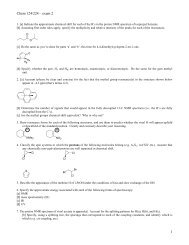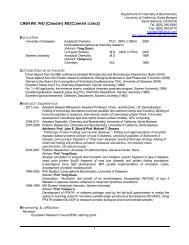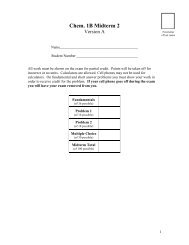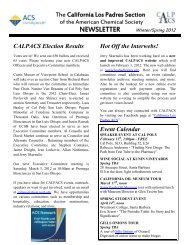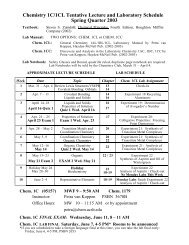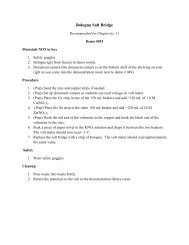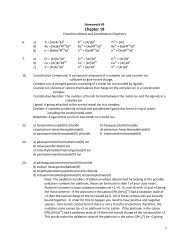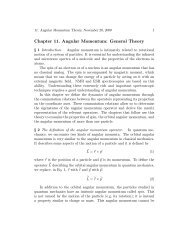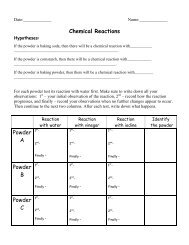Polarity of Water: Activities or Demonstrations
Polarity of Water: Activities or Demonstrations
Polarity of Water: Activities or Demonstrations
You also want an ePaper? Increase the reach of your titles
YUMPU automatically turns print PDFs into web optimized ePapers that Google loves.
<strong>Polarity</strong> <strong>of</strong> <strong>Water</strong>: <strong>Activities</strong> <strong>or</strong> <strong>Demonstrations</strong>Jumping paper: To show the attractive f<strong>or</strong>ce between water molecules.Standards Addressed:Grade 4: 1eGrade 5: 1b, 1gMaterials:• Clear plastic cup filled half-way with water• NewspaperProcedure: Cut a thin, long strip <strong>of</strong> paper, 0.25′′ wide and 17′′ long <strong>or</strong> longer. Newspaperw<strong>or</strong>ks well. Use the edge <strong>of</strong> a blade <strong>of</strong> a pair <strong>of</strong> sciss<strong>or</strong>s to curl the strip <strong>of</strong> paper and make a 90degrees fold a ½ inch from the end. You can also fold the entire strip <strong>of</strong> paper acc<strong>or</strong>dion style.Fill a clear plastic cup half way with water. Soak the folded end <strong>of</strong> the strip in the cup <strong>of</strong> water.Take the strip out <strong>of</strong> the water. Slowly bring the wet end <strong>of</strong> the curled paper near the water andwatch it “jump” towards the water. Gently pull it out <strong>of</strong> the water – you can see it hold on andthen release with a jump. Ask students to explain this observation. <strong>Water</strong> is strongly attracted toitself. Why? <strong>Water</strong> is a polar molecule. It has a net negative charge on the oxygen and a netpositive charge on the hydgrogen.–++The oxygen atoms <strong>of</strong> water molecules are attracted to hydrogen atoms <strong>of</strong> other water moleculesbecause negative and positive charges attract.Bending <strong>Water</strong>: Static electricity can be a problem when the humidity is low. It causesshocks and makes dust stick to surfaces, and it can literally make your hair stand on end. In thisexperiment, you will see that it also can move things around. This experiment will not w<strong>or</strong>k ifthe humidity is high.Materials:• a nylon comb <strong>or</strong> a balloon• a water faucetProcedure: Adjust the faucet to produce a small stream <strong>of</strong> water. The stream should beabout 1.5 millimeters (1/16 inch) in diameter.
Run the comb through your hair several times. Slowly bring the teeth <strong>of</strong> the comb near thestream <strong>of</strong> water, about 8 to 10 centimeters (3 <strong>or</strong> 4 inches) below the faucet. When the teeth <strong>of</strong> thecomb are about an inch <strong>or</strong> less away from the stream, the stream will bend toward the comb.Move the comb closer to the stream. How does the distance between the stream and the combaffect how much the stream bends? Run the comb through your hair several m<strong>or</strong>e times. Doesthe comb bend the stream m<strong>or</strong>e now?Change the size <strong>of</strong> the stream by adjusting the faucet. Does the size <strong>of</strong> the stream affect howmuch the stream bends?If you have other combs, you can try these to see if some bend the stream m<strong>or</strong>e than others. Oryou can use a balloon. Rub the balloon on a piece <strong>of</strong> clothing to build up charge on the balloon.Static electricity is the accumulation <strong>of</strong> an electrical charge in an object. The electricalcharge develops when two objects are rubbed against one another. When the objects are rubbedtogether, some electrons (charged components <strong>of</strong> atoms) jump from one object to the other. Theobject that loses the electrons becomes positively charged, while the object that they jump tobecomes negatively charged. The nature <strong>of</strong> the objects has a large effect on how many electronsmove. This determines how large an electrical charge accumulates in the objects. Hair and nylonare particularly good at acquiring charge when they are rubbed together.Attraction between Opposite Charges (+/–): A charged object attracts smallparticles, such as dust. The charge in the object causes a complementary charge to develop insomething close to it. The complementary charge is attracted to the charged object. If thecomplementary charge f<strong>or</strong>ms on something tiny, such as dust particles, these tiny particles moveto the charged object. This is why your television screen becomes dusty faster than the televisioncabinet. When a television operates, electrons fly from the back to the screen. These electronscause the screen to become charged. The charge on the screen attracts dust.The comb attracts the stream <strong>of</strong> water in the same way. The charge on the comb attracts themolecules <strong>of</strong> water in the stream. Because the molecules in the stream can be moved easily, thestream bends toward the comb.When you comb your hair with a nylon comb, both the comb and your hair become charged. Thecomb and your hair acquire opposite charges. Because the individual hairs acquire the samecharge, they repel each other. Perhaps you noticed that after running the nylon comb throughyour hair, the hairs on your head stood on end. This is a result <strong>of</strong> your hairs repelling each otherbecause they are charged.Humidity: Static electricity is m<strong>or</strong>e <strong>of</strong> a problem when humidity is low. When humidity ishigh, most surfaces are coated with a thin film <strong>of</strong> water. When objects coated by a film <strong>of</strong> waterare rubbed together, the water prevents electrons from jumping between the objects.Reference: Chemical <strong>Demonstrations</strong>, A Handbook f<strong>or</strong> Teachers in Chemistry by BassamZ. Shakashiri, VOL. 3, Page 329http://scifun.chem.wisc.edu/HOMEEXPTS/BENDWATER.html




